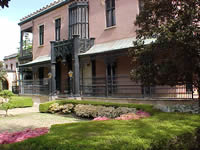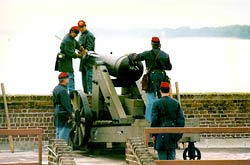

Savannah Ga
Savannah is one of America's great cities and is rich with history from the Civil War. During the Civil War, it was one of the most important cities for the Confederacy, and the goal of Gen. W.T. Sherman's army as he marched to the sea to resupply his men in late 1864. Today it boasts more than 1,200 historic structures, 20 beautiful squares, and much, much more. You can begin your tour by going to the Savannah Visitors Center. Several days are needed to see all the area has to offer. There are some general Civil War sites not to be missed.
Savannah Visitors Center
Savannah offers a wide range of tours and related activities. As a result, fees vary. Information is available from the Savannah Visitors Center, in the restored Central of Georgia railroad station
Savannah Visitor Information Center
301 Martin Luther King Blvd.
Savannah, GA 31401
912.944.0455
Monday - Friday 8:30 a.m.- 5 p.m.
Saturday, Sunday and Holidays 9 a.m.- 5 p.m.
Green-Meldrim House
This Gothic Revival style home, built in 1853 at the princely sum of $93,000, served as the headquarters of Gen. W.T. Sherman from Dec. 22, 1864 to Feb. 1, 1865. Charles Green, an English immigrant and cotton trader who made his fortune with Andrew Low & Company in Savannah, was in Europe in 1861 when the War began. Making his way back to the U.S. through Canada, he was arrested in Detroit, charged with spying, and sent to Fort Warren prison in Boston Harbor for three months. When released, he returned to Savannah.
In December of 1864, when Sherman occupied the town, Green offered his home, considered to be the town's finest, to the General, thinking this would spare it the treatment others had received at the hands of Sherman's army. Sherman accepted, and his men did not disturb Green's possessions. From here, Sherman sent his famous message to President Lincoln, reprinted in many newspapers of the day: "I beg to present to you as a Christmas gift, the City of Savannah with 140 heavy guns and plenty of ammunition and also about 25,000 bales of cotton." While Sherman stayed here, he learned of the death of his son Charles, whom he'd never seen, and planned his march through South Carolina. After the War, Sherman returned to Savannah and stayed again at Green's home. This National Historic Landmark has many fascinating features and is open for tours
14 West Macon St., Savannah 912-233-3845
Fort Jackson 
Fort James Jackson, also known as Old Fort Jackson, has been a part of Coastal Georgia’s history for nearly two centuries. Named in honor of Georgia governor and Revolutionary War soldier James Jackson, the fort is the oldest standing brick fortification in the state. Fort Jackson is also a National Historic Landmark, and is listed on the National Register of Historic Sites. The fort is one of only eight Second System fortifications (a series of forts built prior to the War of 1812) still standing in the United States. It served as headquarters for the Confederate Savannah River defenses during the American Civil War.
Old Fort Jackson is now owned by the state of Georgia, but operated by the non-profit Coastal Heritage Society. Fort Jackson receives no federal or state funding for its operations. Thousands of visitors enjoy the fort every year, including numerous student and scout groups, as well as people who rent the fort for community events or after-hours gatherings. Old Fort Jackson is also known for its daily cannon firing demonstrations each summer, and is the only historic fort in the United States delivering cannon salutes to passing military vessels.
Open Daily: 9:00 a.m- 5:00 pm
Closed Thanksgiving Day, Christmas Day, New Year’s Day
Admission: $4.25
Looking for more information on Savannah Click Here
Home Site Map Link to us Contact us
Site owned and operated by CSA Media Copyright 2006-2007